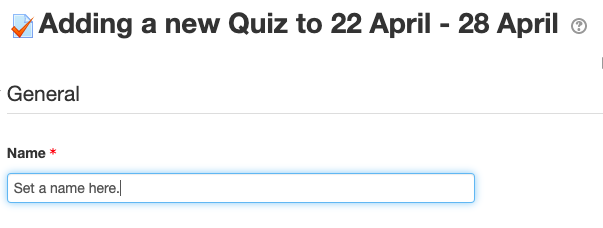One common way to design an exam is to give students some choice over which questions they answer. We see this most commonly with essays - “write an essay on one of the following 3 prompts” or the like. Students may perform better if they can pick questions where they feel more confident; giving the students some agency may also decrease the incentive to cheat. Unfortunately, Moodle doesn’t handle this design well, because it assumes that all questions on a quiz are mandatory. We have some strategies which enable this design.
HOW TO MAKE QUIZZES
1. Add an activity on your course page on the desired week.

2. Scroll through "Add an activity or resource" popup and click on Quiz. 
3. Add a name and a description for the quiz.
4. Save and return to the course page. 
5. Click on the same quiz on the course page.
6. Click Edit quiz. 
7. Click Add and select a new question.

8. Select a quiz type, then add the question. 
9. Make sure to save changes.
Simple Approaches: Give as Many Questions as Expected Answers
These approaches have the benefit of working well with Moodle’s grading system, and they're fast to implement. The simplest version, if you’re giving multiple possible prompts for a single essay, is just to put them in the Question Text field and have the students clearly label which essay they’re answering.
If you have more than one essay required (like “write 5 of these 8 short answer questions”), you can accomplish the same thing by putting the prompts in a Description (the bottom option when adding a question), and then creating one Essay question for each answer the student is required to give. Give the Essays question names like “Essay One” and Question Texts like “Write your first essay here.” Again, you’ll have to direct students to clearly label which essay they’re answering.
More Complex: Treating Each Question Separately
There are benefits to having each question exist as a separate entity. Having each question separate will give you a clear visual indicator in the Quiz grading interface of which questions were more and less popular. Some faculty like to grade all of the answers to a specific question as a batch, and separate questions would make that much easier. You can also use this process to create "extra credit" questions on a quiz.
This is a 3-step process: setting up the quiz itself, checking the grading options for the quiz, and then making an edit in the Gradebook.
Setting the Quiz itself up is very easy - just make one question per question asked.
Setting up the grading is where this gets a little complicated. In the Quiz, enter the appropriate point value for each question - i.e. the number you want to grade the essays out of. You’ll notice the “total marks” for the quiz are now significantly inflated, since you’ve got a maximum score of “all possible questions” instead of “all mandatory questions.” For example, if you've got 6 total questions each graded out of 20 points, but students only have to answer 5, the total marks would be 120 instead of 100.

But we have a way to deal with this. In the Gradebook, the “Multiplicator” field lets you adjust all scores on an exercise. We’ll use that feature to scale the points assigned up to the appropriate percentage.
Take the Moodle “total marks” for the Quiz, and divide it by the real total points you will be assigning. (Write the result down. For the example above, it's 1.2.)
Go to your Gradebook, and go to Setup. Find the row for the quiz, and click Edit, and then Edit Settings. This will bring up the grade settings for the quiz.
Click “Show more” and find the Multiplicator field. Enter that quotient you wrote down into the Multiplicator field.

(For example, if I offered 2 essay questions, each graded out of 100 points, I’d have “total marks” of 200 / “real maximum” of 100, for a Multiplicator of 2. If I wanted students to write 5 of 8 short answers, each graded out of 10, I’d have total marks of 80 / real maximum of 50, for a Multiplicator of 1.6. In the Gradebook, Moodle will multiply the student's points achieved by the Multiplicator, and then divide by the "total marks", so they get the appropriate percentage grade on the exam.)
We’ve used essays as our example, but this would work for any question type. You could also use these "optional questions" as "extra credit" questions; if a student does more questions than required, the Multiplicator will automatically give them extra credit up to 100% of the exam grade.